Wisconsin Supreme Court Decision Raises Concern: Landowner May Be Liable for Damage Caused by a Commercial Applicator to a Neighboring Property?
(Kelli Brandenburg v. Robert Luethi Trempealeau County Circuit Court, J. Crooks decision)
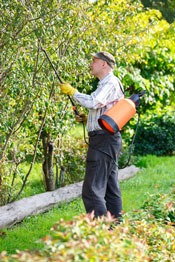 Robert Luethi hired an independent contractor to spray herbicide on his property. The spraying resulted in damage to trees on a neighbor’s property. Brandenburg filed suit against Luethi for the damage and loss of trees. The circuit court said the spraying was not “abnormally dangerous” or “ultrahazardous” and therefore Luethi was not liable for the damage, only the independent contractor was liable. Brandenburg appealed. The appeals court reversed saying the circuit court relied on an improper standard, the determination should have been if the activity was “inherently dangerous.” Upon review, the Supreme Court affirmed the appeals court finding that the activity was inherently dangerous. The case is remanded for further proceedings to determine “whether Luethi exercised ordinary care to prevent damage to Brandenburgs’ property.” Robert Luethi hired an independent contractor to spray herbicide on his property. The spraying resulted in damage to trees on a neighbor’s property. Brandenburg filed suit against Luethi for the damage and loss of trees. The circuit court said the spraying was not “abnormally dangerous” or “ultrahazardous” and therefore Luethi was not liable for the damage, only the independent contractor was liable. Brandenburg appealed. The appeals court reversed saying the circuit court relied on an improper standard, the determination should have been if the activity was “inherently dangerous.” Upon review, the Supreme Court affirmed the appeals court finding that the activity was inherently dangerous. The case is remanded for further proceedings to determine “whether Luethi exercised ordinary care to prevent damage to Brandenburgs’ property.”
The Wisconsin Supreme Court determined that spraying a pesticide is an “inherently dangerous activity” therefore both the contractor and the individual landowner that hired the contractor are responsible for taking precautions to reduce risk of offsite damage. Hence, the court ordered further actions to determine if Luethi, the landowner should have taken more actions to prevent offsite damage to his neighbor’s property.
The WDATCP investigation indicated that pesticide drift occurred resulting in a $3300 civil forfeiture for the Commercial Application Business involved.
[top]
Japanese Beetles
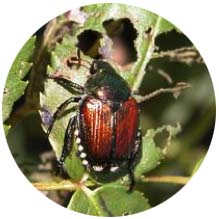 Expect company at your fourth of July picnic. We have already had a report of one Japanese beetle adult in southern Lake County. A Plant Clinic volunteer reported this finding to us on June 24. Japanese beetles are up to 1/2 inch long, and have oval, metallic green bodies with coppery brown wingcovers (figure 2). They appear to have five white spots along each side and two additional white spots behind their wing covers. Upon examination under a hand lens, the spots are actually tufts of white hair. Expect company at your fourth of July picnic. We have already had a report of one Japanese beetle adult in southern Lake County. A Plant Clinic volunteer reported this finding to us on June 24. Japanese beetles are up to 1/2 inch long, and have oval, metallic green bodies with coppery brown wingcovers (figure 2). They appear to have five white spots along each side and two additional white spots behind their wing covers. Upon examination under a hand lens, the spots are actually tufts of white hair.
Adult beetles feed on nearly 300 different species of ornamental plants with about 50 species being preferred. Highly preferred hosts include rose, crabapple, cherry, grape, and linden. The adults feed on leaf tissue between veins, resulting in skeletonized leaves (figure 3). Severely infested plants may be almost completely defoliated. Early infestations of Japanese beetle may be missed since the insects start feeding in the tops of trees. Japanese beetles overwinter as larvae (grubs) about four to eight inches beneath the soil surface. In spring, as the soil temperatures warm to about 55° F, the grubs move upward through the soil to pupate. Adults normally emerge from late June through July. Within a few days after emergence, the females mate and burrow into the soil to lay eggs.
Nearly all eggs are laid by mid-August. In sufficiently warm and moist soil, eggs will hatch in about ten days. Last winter's deep frost line may have killed some of the grubs. We'll have to wait and see what size population emerges. Larvae (grubs) feed on plant roots until cold weather forces them to greater depths in the soil for the winter. There is one generation of this beetle per year.
(Source: Morton Arboretum)
[top]
Fire Blight on Callery Pear
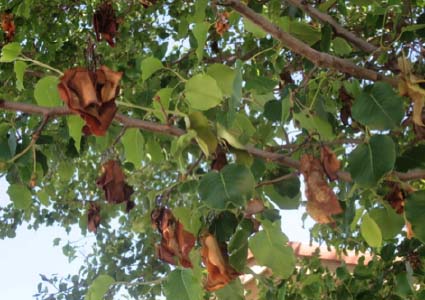
“Fire blight symptoms were observed on several Callery pears this past week,” says Travis Cleveland, University of Illinois extension specialist.
“The symptoms were more severe than those observed during the 2013 growing season.”
Fire blight is a bacterial disease that affects rosaceous plants. Apples, pears, crabapples, and ornamental pears are the most seriously affected species. Other rosaceous hosts include: cotoneaster, hawthorn, quince, firethorn, and mountain-ash.
On Callery pear, look for water-soaked or wilted new growth that quickly turns black and remains attached to the stem. Affected foliage is usually at the branch tip. Symptoms will look similar to frost injury. The affected foliage on other host species usually turns brown. Dark cankers also develop in the wood of infected stems and branches.
Fire blight is caused by a bacterium (Erwinia amylovora). The pathogen overwinters in living tissue at the margins of trunk and branch cankers that were formed by infections initiated in previous years. The disease can cause numerous cankers on a single tree.
Not all cankers survive the winter, but the few that persist produce millions of bacteria capable of causing new infections. Rain or insects may move the bacterium from cankers to open blossoms, vigorous shoot tips, and leaves. Fire blight outbreaks sometimes occur following severe storms. Gusty winds and hail wound the trees creating an entry point for the pathogen. The bulk of infections occur during flowering when temperatures are warm (optimal 76°F) and conditions are wet. These conditions also encourage rapid disease development.
An important step to controlling fire blight is the selection of resistant cultivars such as Cleveland Select or Bradford. Avoid highly susceptible cultivars such as Aristocrat, Autumn Blaze, and Red Spire.
There is no effective management option for infected trees. Prune out infected wood in the dormant season, if you can wait. If not, prune in an extended dry period and disinfect pruning tools after every cut. The bacterium may have extended down the stem ahead of the canker. Unfortunately this means wood should be removed 8-10 inches below the edge of the visible canker.
Chemical options are limited, especially for home growers and the timing of sprays are also critical. Commercial growers apply copper products in the dormant season and streptomycin at 4-5 day intervals throughout bloom. Fertilization and watering are not recommended. Such practices will promote lush growth, which is more susceptible to infection by the fire blight bacterium.
Source: Travis Cleveland, Visiting Extension Specialist, PSEP, tclevela@illinois.edu
[top]
Imidacloprid 0.5G Grub Control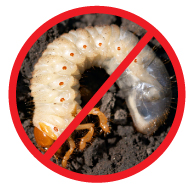
Benefits of Imidacloprid grub control
For systemic control of soil inhabiting pests in turfgrass and landscape plantings; featuring low use rates, application flexibility and great value.
Proven performer, Imidacloprid, provides excellent broad spectrum control.
Provides long term control of lawn, turf and landscape pests such as white grubs.
Low use rates, designed specifically for soil application.
Convenient granular formulation for broadcast application to turf and ornamentals.
To order or obtain additional information please contact us.
[top]
0-0-7 SOP w/.067% Acelepryn Preemergent Grub

DuPont™ Acelepryn® insecticides provide lawn care professionals and golf course superintendents reliable and consistent grub control. Acelepryn® is more than outstanding grub control, it also controls many key surface feeding pests including annual bluegrass weevils, billbugs and caterpillars.
DuPont™ Acelepryn® is the only turf product in Group 28, the anthranilic diamides. This is the latest insecticide class recognized by IRAC (Insecticide Resistance Action Committee). It features a novel mode of action that impacts the insect's muscles. In addition to the distinct mode of action, Acelepryn® is setting standards in environmental and toxicological areas.
• 0-0-7 SOP w/.067% Acelepryn Preemergent Grub label 
To order or obtain additional information please contact us.
[top]
ArborFos from Mauget
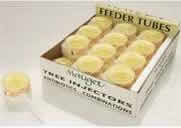 ArborFos from Mauget is a fungicide containing phosporous acid 45.8%. ArborFos works by triggering the trees natural defense system. It is a micro-injection treatment targeting Anthracnose, Bacteria Blight, Apple Scab and Fire Blight. While imparting no phosphorus nutrition, ArborFos rapidly augments new root, stem and leaf growth as disease pressure is lowered. ArborFos from Mauget is a fungicide containing phosporous acid 45.8%. ArborFos works by triggering the trees natural defense system. It is a micro-injection treatment targeting Anthracnose, Bacteria Blight, Apple Scab and Fire Blight. While imparting no phosphorus nutrition, ArborFos rapidly augments new root, stem and leaf growth as disease pressure is lowered.
» Purchase Online
[top]
Tree Watering Bags
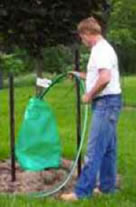 Tired of standing next to a newly planted tree with a hose and seeing most of the water running away from the tree into the grass? Then make your job easier and more effective --- use a National Seed Tree Watering Bag! The National Seed Tree Watering Bag distributes approximately 20 gallons of water around the base of the tree over a 4-6 hour period. This allows the water to be absorbed into the ground rather than run off. This is very useful when planting a new tree or watering a young tree in the dry time of the year. Tired of standing next to a newly planted tree with a hose and seeing most of the water running away from the tree into the grass? Then make your job easier and more effective --- use a National Seed Tree Watering Bag! The National Seed Tree Watering Bag distributes approximately 20 gallons of water around the base of the tree over a 4-6 hour period. This allows the water to be absorbed into the ground rather than run off. This is very useful when planting a new tree or watering a young tree in the dry time of the year.
» Download Information Sheet
» Purchase Online
[top]
Contact your sales rep for more information:
Tom Breier: tom.breier@natseed.com (630) 417-9054
Tim Breier: tim.breier@natseed.com (630) 417-9056
Dan Breier: dan.breier@natseed.com (630) 417-9055
Mark Breier: mark.breier@natseed.com (630) 417-9057
Kevin Spiller: kevin.spiller@natseed.com (630) 903-5240 |